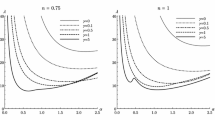Abstract
Transient propagation of weak pressure perturbations in a homogeneous, isotropic, fluid saturated aquifer has been studied. A damped wave equation for the pressure in the aquifer is derived using the macroscopic, volume averaged, mass conservation and momentum equations. The equation is applied to the case of a well in a closed aquifer and analytical solutions are obtained to two different flow cases. It is shown that the radius of influence propagates with a finite velocity. The results show that the effect of fluid inertia could be of importance where transient flow in porous media is studied.
Similar content being viewed by others
Abbreviations
- b :
-
Thickness of the aquifer, m
- c 0 :
-
Wave velocity, m/s
- k :
-
Permeability of the porous medium, m2
- n :
-
Porosity of the porous medium
- p(\(\bar x\),t):
-
Pressure, N/m2
- Q :
-
Volume flux, m3/s
- r :
-
Radial coordinate, m
- r w :
-
Radius of the well, m
- s :
-
Transform variable
- S :
-
Storativity of the aquifer
- S d(r, t):
-
Drawdown, m
- t :
-
Time, s
- T :
-
Transmissivity of the aquifer, m2/s
- \(\bar v\)(\(\bar x\),t):
-
Velocity of the fluid, m/s
- \(\bar x\) :
-
Coordinate vector, m
- z :
-
Vertical coordinate, m
- α :
-
Coefficient of compressibility, m2/N
- β :
-
Coefficient of fluid compressibility, m2/N
- ε :
-
Relaxation time, s
- φ(r, t):
-
Hydraulic potential, m
- μ :
-
Dynamic viscosity of the fluid, Ns/m2
- ξ :
-
Dimensionless radius
- ρ :
-
Density of the fluid, Ns2/m4
- σ(ξ, τ):
-
Dimensionless drawdown
- τ :
-
Dimensionless time
- ζ, x :
-
Dummy variables
- δ 0,δ 1 :
-
Auxilary functions
References
Bear, J.,Hydraulics of Ground Water. John Wiley and Sons, New York (1979).
Bear, J. and Bachmat, Y., Macroscopic modelling of transport phenomena in porous media. 2: Application to mass, momentum and energy transportTransp.Porous Media, 1 (1986) 241–270.
Bear, J. and Bachmat, Y.,Introduction to Modelling of Transport Phenomena in Porous Media. Kluwer Academic Publishers, Dordrecht (1990) pp. 177, 268–286, 300–301.
Bear, J. and Verruijt, A.,Modelling Groundwater Flow and Pollution. Kluwer Academic Publishers, Dordrecht (1987) pp. 56–65.
Carslaw, H.S. and Jaeger, J.C.,Conduction of Heat in Solids. Oxford University Press, Oxford (1980) pp. 334–339.
Erdelyi, A. (ed.),Higher Transcendental Functions. Vol. 2, McGraw-Hill Book Company, New York (1953) p. 62.
Foster, W.R., McMillen, J.M. and Odeh, A.S., The equations of motion of fluids in porous media: 1. Propagation velocity of pressure pulses.Soc. Pet. Eng. J. 7 (1967) pp. 333–341.
Morin, R.H. and Olsen, H.W., Theoretical analysis of the pressure response from a constant flow rate hydraulic conductivity test.Water Resour. Res. 23 (1987) 1461–1470.
Muskat, M.,The Flow of Homogeneous Fluids Through Porous Media, McGraw-Hill Book Company, New York (1937) pp. 130–131.
Oroveanu, T. and Pascal, H., On the propagation of pressure waves in a liquid flowing through a porous medium.Rev. Mec. Appl., Acad. R.P.R. 4 (1959) pp. 445–448.
Pascal, H., Pressure wave propagation in a fluid flowing through a porous medium.Int. J. Eng. Sci. 24,No. 9 (1986) 1553–1570.
Polubarinova-Kochina, P. Ya.,Theory of Ground Water Movement. Princeton University Press, Princeton (1962) pp. 22–23, 481–484.
Rehbinder, G., Darcyan flow with relaxation effect.Appl. Sci. Res. 46 (1989) 45–72.
Shapiro, A.M., Interpretation of oscillatory water levels in observation wells during aquifer tests in fractured rock.Water Resour. Res. 25 (1989) 2129–2137.
van der Kamp, G., Determining aquifer transmissivity by means of well response tests: the under damped case.Water Resour. Res. 12 (1976) 71–77.
Whitaker, S., Flow in porous media 1: A theoretical derivation of Darcy's law.Transp. Porous Media 1 (1986) 3–25.
Author information
Authors and Affiliations
Rights and permissions
About this article
Cite this article
Löfqvist, T., Rehbinder, G. Transient flow towards a well in an aquifer including the effect of fluid inertia. Appl. Sci. Res. 51, 611–623 (1993). https://doi.org/10.1007/BF00868003
Received:
Accepted:
Issue Date:
DOI: https://doi.org/10.1007/BF00868003




